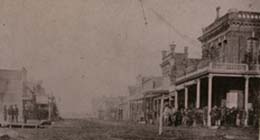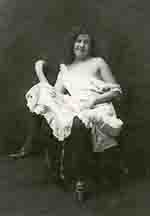
Victoria's Secret:
1859-1866
| The Dance Floor |
| Sexual History |
| Nightly Entertainment |
| Stakeholders |
| Local Halls |
| Original Sources |
| Citations |
| About Us |
| Clothing |
The Native women working in the dance houses attempted to gain respectability in many ways, foremost amongst which was their style of dress. The women understood that in Victorian society appearance was extremely important, and so they attempted—to the scorn of many—to fit into the society by dressing the part. Native women attempted to dress well and tastefully—according to Victorian standards, donning “the silk dress and the dainty garter, with the air of a Parisian dame.”* Bishop Hills escribed “a woman making up a dress” that she intended for the dance hall in his diary. Women wearing full hoop skirts and being arrested for prostitution is well documented; for example, in May 1860, the six Native women arrested as “common street walkers” were wearing “hoops so large that they could scarcely get inside the railing.”* The finery of the Native women working in dance halls is more reflective of their desire to fit into mainstream society than it is a reflection of standard dance hall attire of the day. In the (non-Native) dance halls of other gold rush towns, women tended not to dress in silk and garters. In Dawson, Yukon, for example, many of the dance hall performers wore “full-length black skirts and white shirtwaists rather than the feather boas and fishnet stockings we have come to associate them with.”* Yet in Victoria, Native women tended to wear “immense hoops and...silk dress” if the British Colonist's report of a fight between two Native women is to be believed. The clothing these women selected, therefore, does not suggest that they were making an effort to fit into the underworld; it suggests instead that Victoria's Native women attempted—albeit often unsuccessfully—to fit into mainstream Victorian society.
|
| Original Sources | ||
 The dance hall performer known as the Belgian Queen poses for the camera in a local studio (click for full image) |
||